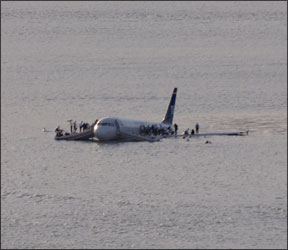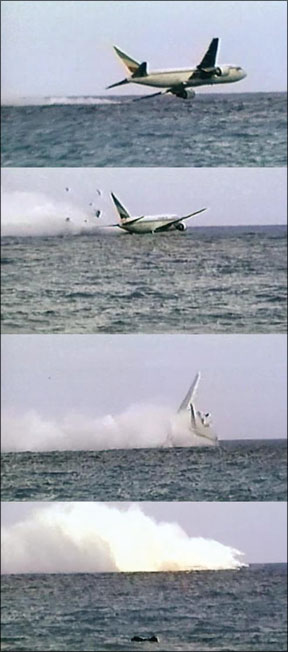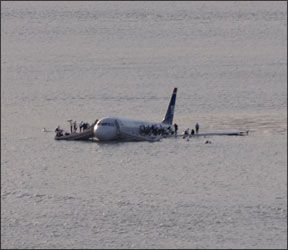The FAAs Aeronautical Information Manual, at paragraph 6-3-3, puts it bluntly: “A successful aircraft ditching is dependent on three primary factors. In order of importance they are: sea conditions and wind, type of aircraft, and the skill and technique of the pilot.” I maintain that the AIM leaves out one critical component of a truly successful ditching: The performance of the crew and passengers, together, during the aircraft ditching and subsequent evacuation of the aircraft.
You want to know how I know? Ive been there. On June 14, 2001, I was piloting a Cessna 210 out of Key West, Fla., on an IFR flight plan heading to Grand Cayman

288
Island. Onboard were my two daughters, ages 8 and 9, their babysitter, age 15, and a 20-year-old first-timer in my airplane. I was the only pilot and we were loaded to maximum gross weight.
Begin by Briefing
I did myself a favor the evening before by briefing the babysitter at the airplane, about her responsibilities both during the flight, and if there was a problem. Being a bantam weight, I decided her best seat would be in the rear, since it was probably the most difficult seat from which to egress. We talked about the slim chance that a problem would occur, and we talked about the options and safety equipment that I had onboard. I showed her how to don her life vest, where the life vests lived, and we talked about the importance of wearing them for takeoff and landing, when wed be low over the water, with no time for donning them.
We briefed on the life raft, which sat between the seats and just behind me. Finally, I showed her the mini SCUBA rescue bottle, with its own regulator, that sits in the seat pocket directly in front of the rear seat passenger. I told her it would give her a couple of minutes, even if she was underwater, and I had her turn it on and take a breath, just so shed know.
We talked about bubbles going up, and that the doors would be against the outside and forward. I had her pull a door handle to see how it opened. Kim paid rapt attention. Shed been in light airplanes before, but not in mine. I didnt want to scare her-just imprint on her the right things to do.
The little girls briefing was a bit more playful. Theyd already had a day in the pool with retired Coast Guard SAR instructor Randy Boone, learning how to inflate, then climb into a raft similar to ours. They knew how to don the vests and inflate them, too.
At home, we played games where they had to unfasten their seatbelts with their eyes closed, reach forward and open the airplane doors, then scamper out. The games kept the mood light, and the kids never worried about getting out if they had to do so.
The morning of our trip I got notice that Id have one more passenger, the young wife of a Cayman Caravan staff member. Shed flown Piper Cherokees, so she was accustomed to sitting next to the aircraft door, and shed flown over water. But we briefed anyhow, and I showed her how the door and window on my plane opened, and told her that I would expect her to open the door on my mark if we had a problem and needed to land. I asked her to reach for the raft (behind us and between the seats) if we needed it. I felt like Id done my job.
Sticky and sultry, it was tough getting people to put on and keep on their horsecollar, airline-style PFDs. The cabin was hot, and I didnt feel like arguing. I knew the cooler air was up at 5000 feet, and I wanted to get there.
The Big Bang
Our climbout was anemic, but I expected that, and held full power just a tad longer than I might have on an ordinary morning. I reduced to 25 inches of manifold pressure and 2500 RPM near 1000 feet AGL. We gained just 1500 feet in the first three minutes. Now talking to NAS Key West Departure, I acknowledged my

288
clearance to Tadpo intersection and started a climbing turn to the left. Thats when I heard it-a bang that you never want to hear in an airplane.
I didnt have to think with that kind of a bang, I just let the nose drop through the horizon, continued the turn around until I saw the island of Key West again and put my thumb back on the push-to-talk. “Mayday. Mayday. Mayday. N211S is no power,” I brusquely interrupted the controller. It got his attention.
“What is the nature of your problem?” he asked.
I looked at the tachometer-zero. I looked up at the spinning prop. The JPI was flashing low voltage and showed no lines for CHT or EGT. “Ive got nothing, no power,” I repeated. My mind was focused on the horizon and the airspeed indicator, trimming like a madwoman for best glide. I pulled out the prop control-anything to extend the glide.
“Youre cleared to land any airport, any runway,” the controller said, realizing I wasnt in a chatty mood.
I looked back at the horizon. The trajectory told the story. We were landing near the beach, but not on any runway. “Unable,” was all I could say back to him.
“Services are on the way,” was his reply. And that was the extent of our conversation. Any other information he needed on me he could get from the Key West tower or my flight plan. I was about to get busy.
In The Water
Frankly, my first concern was the aircraft ditching checklist, which seemed to flow naturally from my memory (Though I dont recall ever memorizing it, I had been flying that particular airplane for 25 years). Speeds, configuration (no flaps, no gear) doors opened and passengers briefed to brace for a hard, wet landing. A glance at the water showed no wind, and only ripples for waves. That part was easy. Three minutes up only took about 1.5 minutes down. But a minute and a half, apparently, was enough time.
I judged our distance to the water and started my flare, skipping once like a flat rock on the surface, and then catching the tail on the second touch, effectively slowing us as the airframe rocked forward, bending at the gear wells, snapping the seat rails and squeezing the windscreen until it popped an eight-inch round hole right out the middle. A wave of water slapped me in the face.
I saw the water coming in the upper left air vent and realized I should not inhale, because I was already underwater. I reached for the door and my hand went through the open window. Tried again and caught the door frame and the door swung away easily. It was about then that I realized I was still strapped in my seat. One pull on the seatbelt latch and my body slipped right out, over the top of the seat and up to the surface right where the wing root and the fuselage meet. I was out.
I looked across the top of the airplane, which was bobbing on the surface, and there was my right seat passenger. I looked in the window, and there were my kids and Kim, waist deep in water, with the water rising. I banged on the window, then ducked back in under the wing and pulled. But it was the babysitter, doing her job, that made the difference. She hollared, “MOVE! SEATBELTS! GET OUT!” and the two girls sprang to life, flipped off their belts and ducked under the water. They grabbed at our ankles and then, there they were, on the surface hanging onto the flaps. The egress didnt take 15 seconds. About a minute later, the airplane disappeared.
We were lucky. We were close to shore, the water was warm and the controller was quick on his SAR button. We were sitting in a boat less than five minutes after we ditched. Everyone could swim, and did, completely forgetting to inflate their life vests. All of the other safety equipment, from the first aid kit to the raft, went down with the airplane. It was a good thing we did not need it.
What I Know Now
A lot of people tell me that I should be proud, that everything turned out okay, and that I handled the emergency well. And I know they are right. But humans were granted hindsight to help them evolve, and after this accident I became aware that there were things about my overwater flying that had to change.
Id guessed this before, but I know it now: There is no time for conversation if you have an engine failure below 1500 AGL. Adjust your heading and trajectory for your landing area, set your best glide speed. Dont get caught up in troubleshooting. Land first. Make it survivable.
And as for what I get to take with me out of the airplane in the case of a water landing? I now know that the only things Ill have with me in the water after a ditching are those that are attached to me. I have new life vests in a fanny-pack style that are comfortable for everyone to don before and keep on during the flight. Even my first aid kit is a fanny-pack that I can and do strap on either myself or a passenger during takeoff and landing.
I learned that a raft has to be small enough and light enough for your weakest link to push or pull it out of the airplane. Id done the right thing and showed a passenger how to use it, but it was too awkwardly placed to be easy for that passenger to maneuver. Now, at least for takeoff and landing, my much smaller, compact raft sits in my passengers lap, near the door. That way, it will come out of the airplane with them.
I have always been, and I am still a firm proponent of taking extra time and care briefing passengers. I show them how the door handles work, how the seatbelts fasten and unfasten, and how to get out of the airplane by simply feeling their way along the cabin walls to the doors, just in case the visibility is zero. I gauge their abilities, and put those most capable by the doors or in a position to help those who might need help. Most of all, though, I make sure that my passengers know that 95 percent of ditchings are survived-and that now they know how to handle an emergency as a team.
The AIM tells us that conditions need to be right and the pilot needs to be skilled, but Im telling you: The key to a successful aircraft emergency also lies in educating your passengers so that they can help themselves, and thereby help you ensure their safety during any aircraft accident.
Amy Laboda is a freelance aviation writer who holds an ATP and CFI. She and her family now fly an RV-10.




